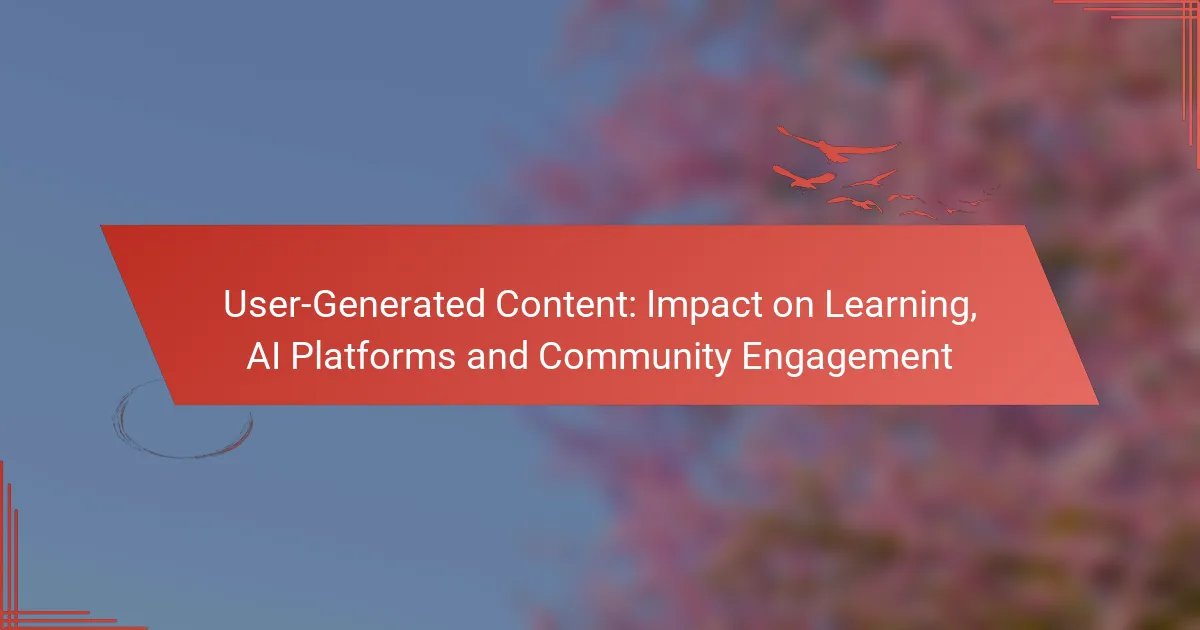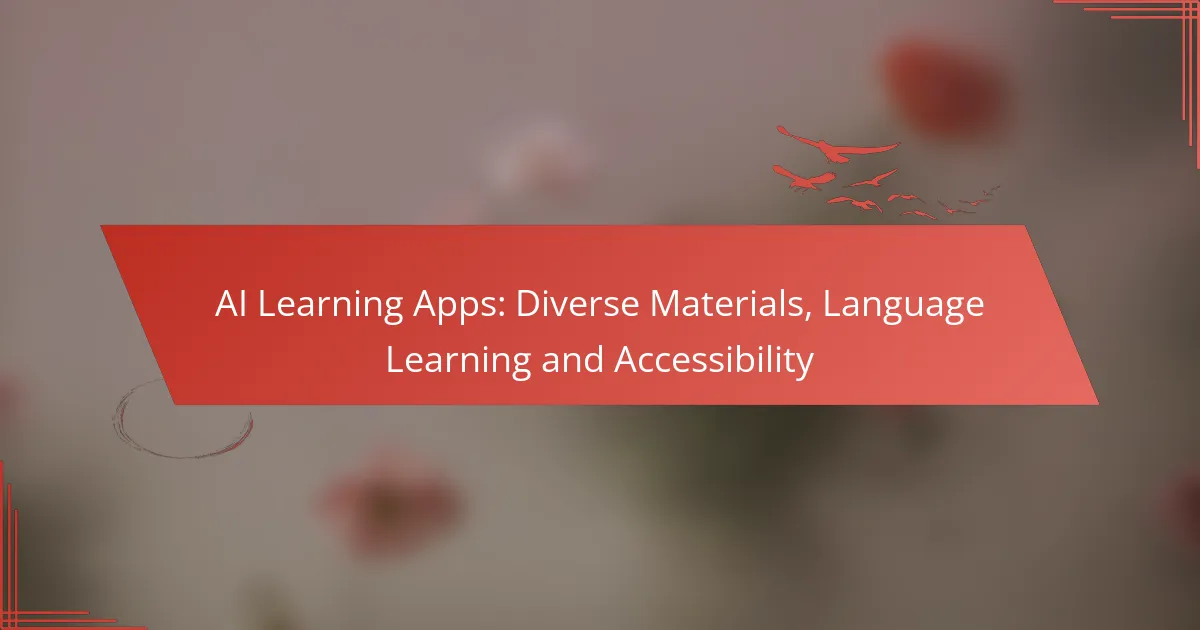User-generated content (UGC) plays a crucial role in enhancing learning and community engagement by promoting collaboration and knowledge sharing among learners. By leveraging AI platforms, UGC is further enriched, as these tools facilitate content creation, moderation, and personalized learning experiences, ultimately fostering a more interactive and connected community.

How Does User-Generated Content Enhance Learning?
User-generated content (UGC) enhances learning by fostering collaboration and enabling learners to share knowledge and experiences. This participatory approach not only increases engagement but also enriches the educational experience through diverse contributions.
Increased engagement through peer interaction
User-generated content promotes active participation among learners, which significantly boosts engagement. When students interact with each other’s contributions, they are more likely to stay motivated and invested in their learning journey.
For instance, platforms that allow students to comment on or edit each other’s work create a collaborative environment. This interaction can lead to deeper understanding as learners explain concepts to one another, reinforcing their own knowledge in the process.
Diverse perspectives on subject matter
User-generated content brings together a variety of viewpoints, enriching the learning experience. Different backgrounds and experiences contribute to a broader understanding of topics, allowing learners to see issues from multiple angles.
For example, in a global classroom setting, students from various countries can share insights on cultural implications of a subject. This diversity not only enhances critical thinking but also prepares learners for real-world scenarios where multiple perspectives are essential.
Real-world applications of theoretical concepts
User-generated content often includes practical examples that connect theory to real-world situations. This application of knowledge helps learners understand how concepts are used outside the classroom, making learning more relevant and impactful.
For instance, students might share case studies or personal experiences related to a theoretical framework, illustrating its use in everyday life. Such real-world connections can improve retention and make abstract ideas more tangible for learners.

What Role Do AI Platforms Play in User-Generated Content?
AI platforms significantly enhance user-generated content by providing tools that facilitate creation, moderation, and engagement. These platforms leverage algorithms to curate content, personalize learning experiences, and analyze data for continuous improvement, ultimately fostering a more interactive community.
Content moderation and curation tools
Content moderation tools on AI platforms help ensure that user-generated content meets community standards and guidelines. These tools can automatically filter inappropriate content, flagging or removing posts that violate policies, which is crucial for maintaining a safe environment.
Curation tools utilize AI to highlight high-quality content, making it easier for users to discover valuable contributions. By analyzing user interactions and preferences, these systems can promote relevant content, enhancing overall engagement and satisfaction.
Personalized learning experiences
AI platforms create personalized learning experiences by analyzing user data to tailor content recommendations. This customization can include suggesting articles, videos, or discussions that align with individual interests and learning styles, making the educational process more effective.
For example, a platform might adapt its curriculum based on a user’s progress, offering additional resources or challenges as needed. This dynamic approach helps keep learners engaged and motivated, ultimately improving retention and understanding of the material.
Data analytics for content improvement
Data analytics tools on AI platforms provide insights into user-generated content performance, helping creators understand what resonates with their audience. By tracking metrics such as engagement rates and feedback, content creators can refine their contributions to better meet user needs.
Additionally, these analytics can identify trends and gaps in content, guiding future creation efforts. For instance, if a particular topic generates high engagement, creators can focus on expanding that area, ensuring that the community remains vibrant and relevant.

How Does User-Generated Content Foster Community Engagement?
User-generated content (UGC) significantly enhances community engagement by allowing individuals to share their experiences and insights. This participatory approach not only builds connections among users but also fosters a sense of ownership and belonging within the community.
Building trust through shared experiences
Trust is cultivated when community members share their personal experiences and stories. User-generated content, such as testimonials, reviews, and case studies, provides authentic insights that resonate with others. For instance, a platform showcasing user reviews can help potential users feel more confident in their decisions.
When users see relatable narratives, they are more likely to engage with the content and the community. This shared understanding creates a supportive environment where members feel valued and heard.
Encouraging collaboration and feedback
User-generated content encourages collaboration among community members by inviting them to share their ideas and feedback. Platforms that facilitate discussions, such as forums or social media groups, allow users to contribute their perspectives, leading to richer conversations and innovative solutions.
For example, a community project that invites user input on design or functionality can lead to enhanced outcomes. Engaging users in this way not only improves the project but also strengthens the community bond as members work together towards common goals.
Creating a sense of belonging
User-generated content plays a crucial role in fostering a sense of belonging within a community. When individuals contribute their thoughts and experiences, they feel more connected to others who share similar interests or challenges. This connection can be particularly powerful in niche communities where members may feel isolated in their offline lives.
To enhance this sense of belonging, communities can highlight user contributions through features like “Member of the Month” or showcase user stories in newsletters. Recognizing individual contributions reinforces the idea that every member’s voice matters, further solidifying community ties.

What Are the Best Practices for Implementing User-Generated Content?
Implementing user-generated content (UGC) effectively requires clear strategies that enhance engagement and maintain quality. Best practices focus on guidelines, feedback integration, and leveraging social media to maximize reach and impact.
Establish clear guidelines for contributions
Setting clear guidelines for user contributions is essential to ensure quality and relevance. Provide specific criteria regarding content type, format, and tone to help users understand what is expected. For example, if you are seeking articles, specify word count and subject matter.
Additionally, outline the review process and any moderation policies. This transparency helps manage user expectations and encourages quality submissions while minimizing inappropriate content.
Incorporate user feedback into content strategy
Integrating user feedback into your content strategy can significantly enhance the relevance and appeal of UGC. Regularly solicit input from users about what content they find valuable and what improvements they suggest. This can be done through surveys or direct comments on existing content.
Use this feedback to refine your guidelines and adapt your content offerings. For instance, if users express interest in specific topics, consider creating more opportunities for contributions in those areas.
Leverage social media for wider reach
Social media platforms are powerful tools for amplifying user-generated content. Share user contributions across your social channels to increase visibility and engagement. Encourage users to share their content on their own networks, which can help attract new audiences.
Consider creating dedicated hashtags or campaigns to promote UGC. This not only fosters community but also makes it easier to track and engage with user contributions. For example, a contest or challenge can motivate users to create and share content while enhancing community interaction.

What Metrics Measure the Impact of User-Generated Content?
Metrics that measure the impact of user-generated content (UGC) include engagement rates, quality of contributions, and community growth. These metrics help assess how effectively UGC enhances learning, fosters interaction, and builds a vibrant community.
Engagement rates and user retention
Engagement rates reflect how actively users interact with UGC, often measured through likes, shares, comments, and time spent on content. Higher engagement typically indicates that users find the content valuable and relevant, which can lead to improved user retention.
To boost engagement, consider implementing gamification elements such as badges or leaderboards. Tracking these metrics over time can help identify trends and inform strategies to enhance user interaction.
Quality of contributions and feedback
The quality of user-generated content is crucial for maintaining a constructive environment. This can be assessed through user ratings, the depth of contributions, and the relevance of feedback provided by peers. High-quality contributions often lead to richer discussions and better learning outcomes.
Encouraging constructive feedback and providing guidelines for contributions can significantly improve quality. Regularly reviewing and curating content can also help maintain high standards and foster a positive community atmosphere.
Community growth and participation levels
Community growth is measured by the increase in active users and the frequency of contributions. Participation levels can be tracked through metrics such as the number of new members, posts, and interactions over time. A thriving community often correlates with a higher volume of UGC.
To encourage growth, consider hosting events or challenges that invite users to contribute. Monitoring participation trends can help identify successful initiatives and areas needing improvement, ensuring the community remains vibrant and engaged.



